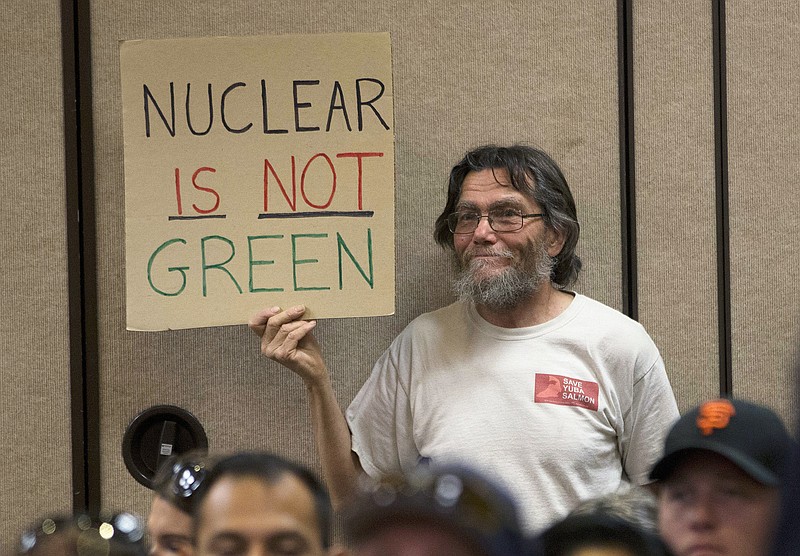PROVIDENCE, R.I. -- As climate change pushes states to dramatically cut their use of fossil fuels, many are coming to the conclusion that solar, wind and other renewable power sources might not be enough to keep the lights on.
Nuclear power is emerging as an answer to fill the gap as states shift away from coal, oil and natural gas to reduce greenhouse gas emissions and stave off the worst effects of a warming planet. The renewed interest in nuclear comes as companies, including one started by Microsoft founder Bill Gates, are developing smaller, cheaper reactors that could supplement the power grid in communities across the U.S.
Nuclear power comes with its own set of potential problems, especially radioactive waste that can remain dangerous for thousands of years. But supporters say the risks can be minimized and that the energy source will be essential to stabilize power supplies as the world tries to move away from carbon dioxide-emitting fossil fuels.
Tennessee Valley Authority President and Chief Executive Officer Jeff Lyash puts it simply: You can't significantly reduce carbon emissions without nuclear power.
"At this point in time, I don't see a path that gets us there without preserving the existing fleet and building new nuclear," Lyash said.
The federally owned utility is adding solar capacity, but also operates three nuclear plants and plans to test a small reactor. By 2050, it hopes to become net zero, which means the amount of greenhouse gases produced is no more than the amount removed from the atmosphere by ocean, atmosphere, soil and forests and other carbon "sinks."
An Associated Press survey of the energy policies in all 50 states and the District of Columbia found that a strong majority-- about two-thirds-- say nuclear, in one fashion or another, will help take the place of fossil fuels. That momentum could lead to the first expansion of nuclear reactor construction in the U.S. in more than three decades.
Roughly one-third of the states and the District of Columbia say they have no plans to incorporate nuclear power in their green energy goals, instead leaning heavily on renewables. They pointed to advances in energy storage using batteries, investments in the grid for high-voltage interstate transmission, energy efficiency efforts to reduce demand and power provided by hydroelectric dams.
The split over nuclear power mirrors a similar debate unfolding in Europe.
The Biden administration has tried to take aggressive steps to reduce greenhouse gases in the U.S. The $1 trillion infrastructure package passed last year will allocate about $2.5 billion for advanced reactor demonstration projects.
U.S. Energy Secretary Jennifer Granholm told the AP the administration wants to get to zero-carbon electricity, and that means nuclear, hydropower, geothermal, wind and solar.
"We want it all," she said.
SAFETY CONCERNS
Nuclear technology still comes with significant risks that other low-carbon energy sources don't, said Edwin Lyman, director of nuclear power safety at the Union of Concerned Scientists. He's concerned the industry might cut corners on safety and security to save money and compete. The group does not oppose using nuclear power, but wants to make sure it's safe.
The U.S. also has no long-term plan for managing or disposing of the hazardous waste, and there remains the danger of accidents or targeted attacks, Lyman said. Nuclear disasters at Pennsylvania's Three Mile Island, Chernobyl and more recently, Fukushima, Japan, in 2011 provide an enduring warning.
Nuclear power already provides about 20% of electricity in the U.S., or about half the nation's carbon-free energy.
The Nuclear Regulatory Commission has approved just one of the new, small modular reactor designs -- from NuScale Power in 2020. Gates' company, TerraPower, wants to build an advanced reactor in Wyoming, which has long depended on coal for power and jobs.
WYOMING WIND POWER
As utilities quit coal, Wyoming is tapping into wind. But Glen Murrell, executive director of the Wyoming Energy Authority, said it's unrealistic to expect all the nation's energy to be provided exclusively through wind and solar.
Georgia maintains that its nuclear reactor expansion will provide "ample clean energy" for 60 to 80 years. New Hampshire said the region's environmental goals would be impossible to meet as affordably without nuclear. Energy agencies in Alaska and Maryland are planning for small modular nuclear reactors.
Other officials, mostly in Democratic-led states, said they're moving beyond nuclear power. Some said they never relied heavily on it to begin with and don't see a need for it.
They said the cost of new reactors compared with installing wind turbines or solar panels, the safety concerns and the unresolved question of how to store hazardous nuclear waste are deal-breakers. Some environmentalists oppose small modular reactors for similar reasons.
New York's future energy grid will be dominated by wind, solar and hydropower, said New York State Energy Research and Development Authority President and CEO Doreen Harris.
Nevada officials don't consider nuclear power a viable option because of the failed plan to store the nation's commercial spent nuclear fuel at Yucca Mountain. Instead, they see potential for energy storage and geothermal energy.
Information for this article was contributed by Matthew Daly of The Associated Press.
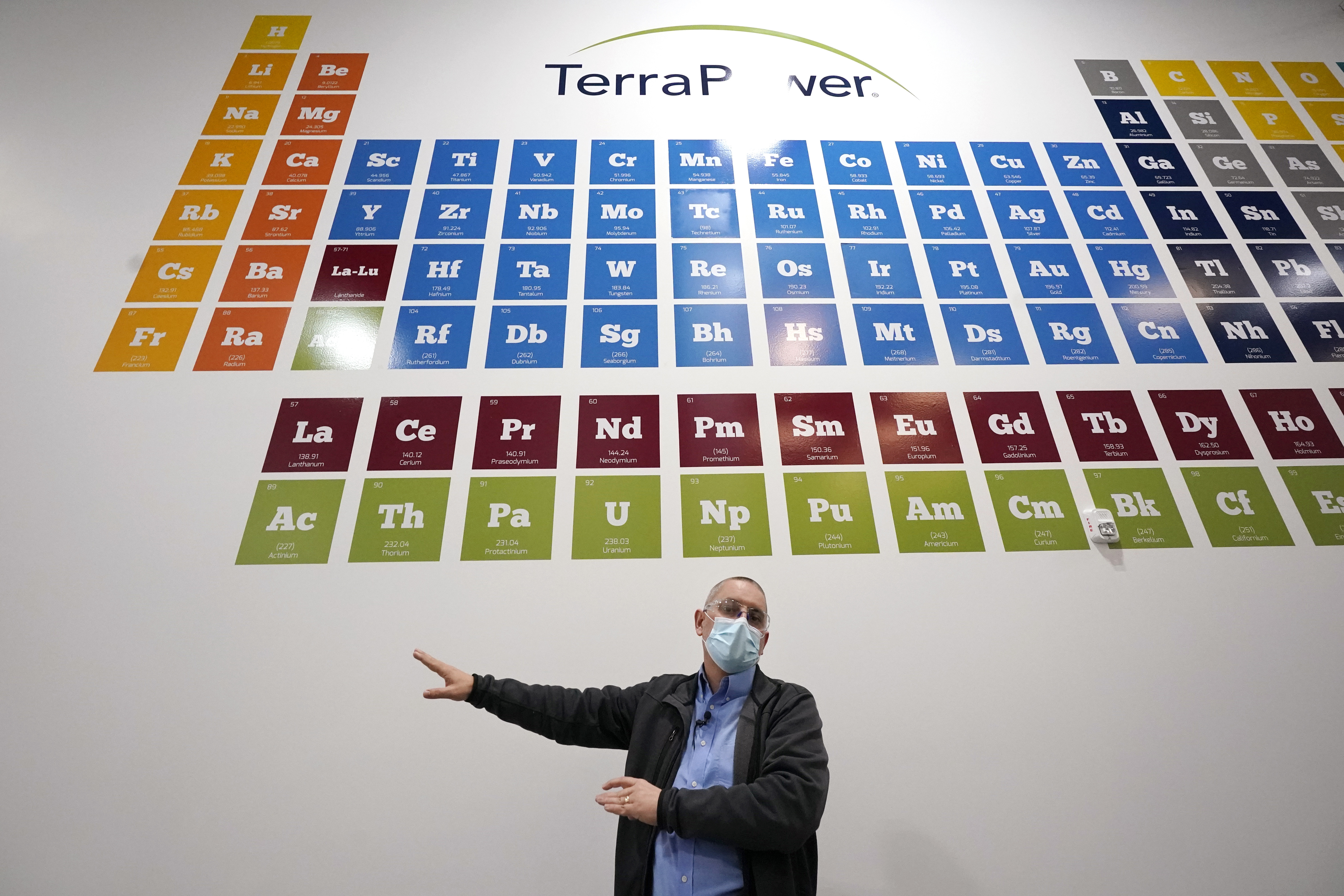 TerraPower's Michael Anderson, manager of test engineers and technicians, talks about the large periodic table on the wall overhead during a tour of the nuclear reactor development facility, Thursday, Jan. 13, 2022, in Everett, Wash. TerraPower plans to make its plant useful for today's energy grid with ever more renewable power. A salt heat "battery" will allow a nuclear plant to ramp up electricity production on demand, offsetting dips in electricity when the wind isn't blowing and sun isn't shining. (AP Photo/Elaine Thompson)
TerraPower's Michael Anderson, manager of test engineers and technicians, talks about the large periodic table on the wall overhead during a tour of the nuclear reactor development facility, Thursday, Jan. 13, 2022, in Everett, Wash. TerraPower plans to make its plant useful for today's energy grid with ever more renewable power. A salt heat "battery" will allow a nuclear plant to ramp up electricity production on demand, offsetting dips in electricity when the wind isn't blowing and sun isn't shining. (AP Photo/Elaine Thompson) A canister containing an ingot of sodium metal is opened at TerraPower, a company developing and building small nuclear reactors, Thursday, Jan. 13, 2022, in Everett, Wash. By cooling a reactor with liquid sodium, a metal that solidifies at well above room temperature, TerraPower says its relatively small, 345-megawatt nuclear plant will be safe and less expensive than conventional, water-cooled nuclear plants. (AP Photo/Elaine Thompson)
A canister containing an ingot of sodium metal is opened at TerraPower, a company developing and building small nuclear reactors, Thursday, Jan. 13, 2022, in Everett, Wash. By cooling a reactor with liquid sodium, a metal that solidifies at well above room temperature, TerraPower says its relatively small, 345-megawatt nuclear plant will be safe and less expensive than conventional, water-cooled nuclear plants. (AP Photo/Elaine Thompson)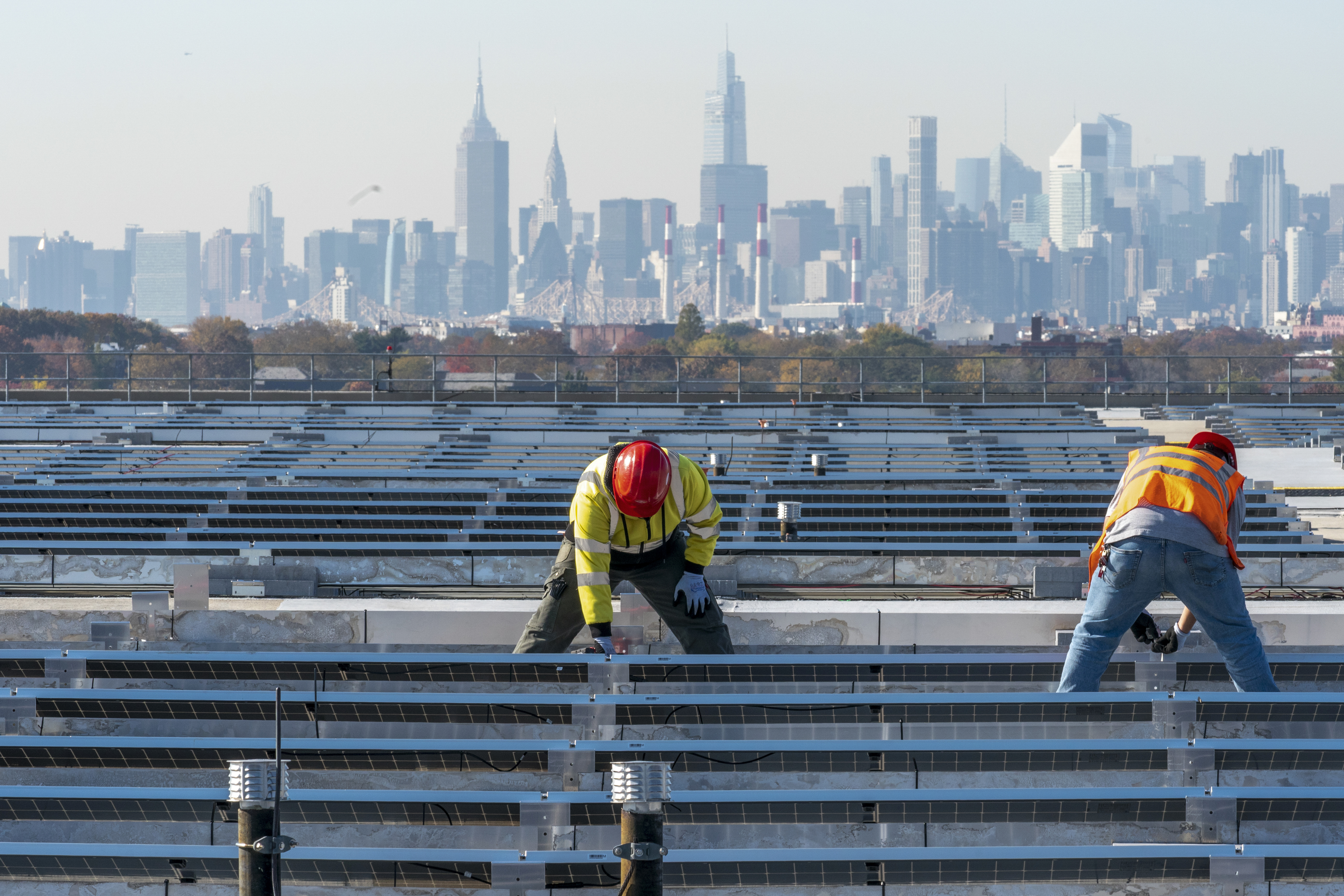 FILE - Framed by the Manhattan skyline electricians with IBEW Local 3 install solar panels on top of the Terminal B garage at LaGuardia Airport, Tuesday, Nov. 9, 2021, in the Queens borough of New York. As climate change pushes states in the U.S. to dramatically cut their use of fossil fuels, many are coming to the conclusion that solar, wind and other renewable power sources won't be enough to keep the lights on. Nuclear power is emerging as an answer to fill the gap as states transition away from coal, oil and natural gas to reduce greenhouse gas emissions and stave off the worst effects of a warming planet. (AP Photo/Mary Altaffer, File)
FILE - Framed by the Manhattan skyline electricians with IBEW Local 3 install solar panels on top of the Terminal B garage at LaGuardia Airport, Tuesday, Nov. 9, 2021, in the Queens borough of New York. As climate change pushes states in the U.S. to dramatically cut their use of fossil fuels, many are coming to the conclusion that solar, wind and other renewable power sources won't be enough to keep the lights on. Nuclear power is emerging as an answer to fill the gap as states transition away from coal, oil and natural gas to reduce greenhouse gas emissions and stave off the worst effects of a warming planet. (AP Photo/Mary Altaffer, File)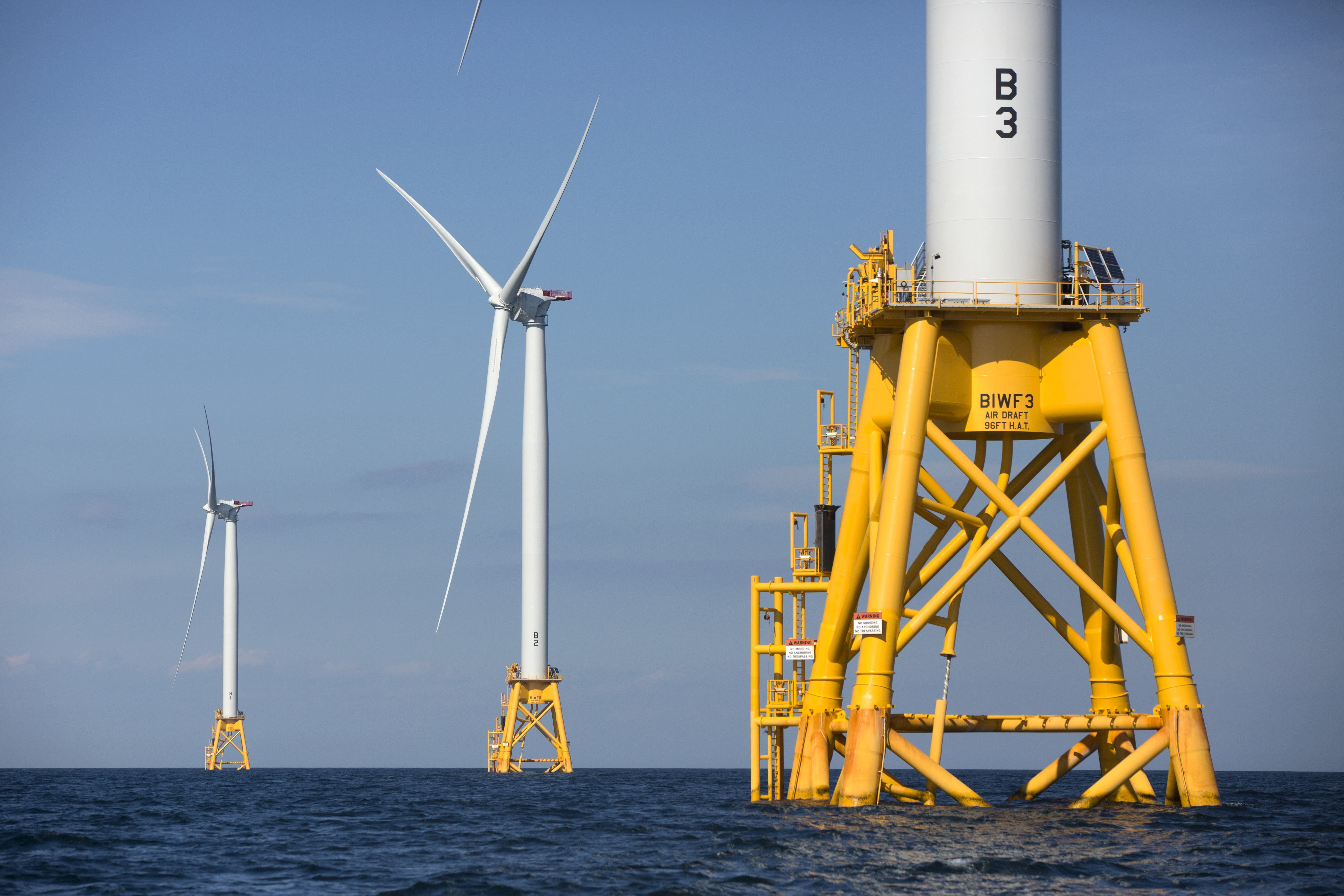 FILE - Three of Deepwater Wind's five turbines stand in the water off Block Island, R.I, the nation's first offshore wind farm on Aug. 15, 2016. As climate change pushes states in the U.S. to dramatically cut their use of fossil fuels, many are coming to the conclusion that solar, wind and other renewable power sources won't be enough to keep the lights on. Nuclear power is emerging as an answer to fill the gap as states transition away from coal, oil and natural gas to reduce greenhouse gas emissions and stave off the worst effects of a warming planet. (AP Photo/Michael Dwyer, File)
FILE - Three of Deepwater Wind's five turbines stand in the water off Block Island, R.I, the nation's first offshore wind farm on Aug. 15, 2016. As climate change pushes states in the U.S. to dramatically cut their use of fossil fuels, many are coming to the conclusion that solar, wind and other renewable power sources won't be enough to keep the lights on. Nuclear power is emerging as an answer to fill the gap as states transition away from coal, oil and natural gas to reduce greenhouse gas emissions and stave off the worst effects of a warming planet. (AP Photo/Michael Dwyer, File)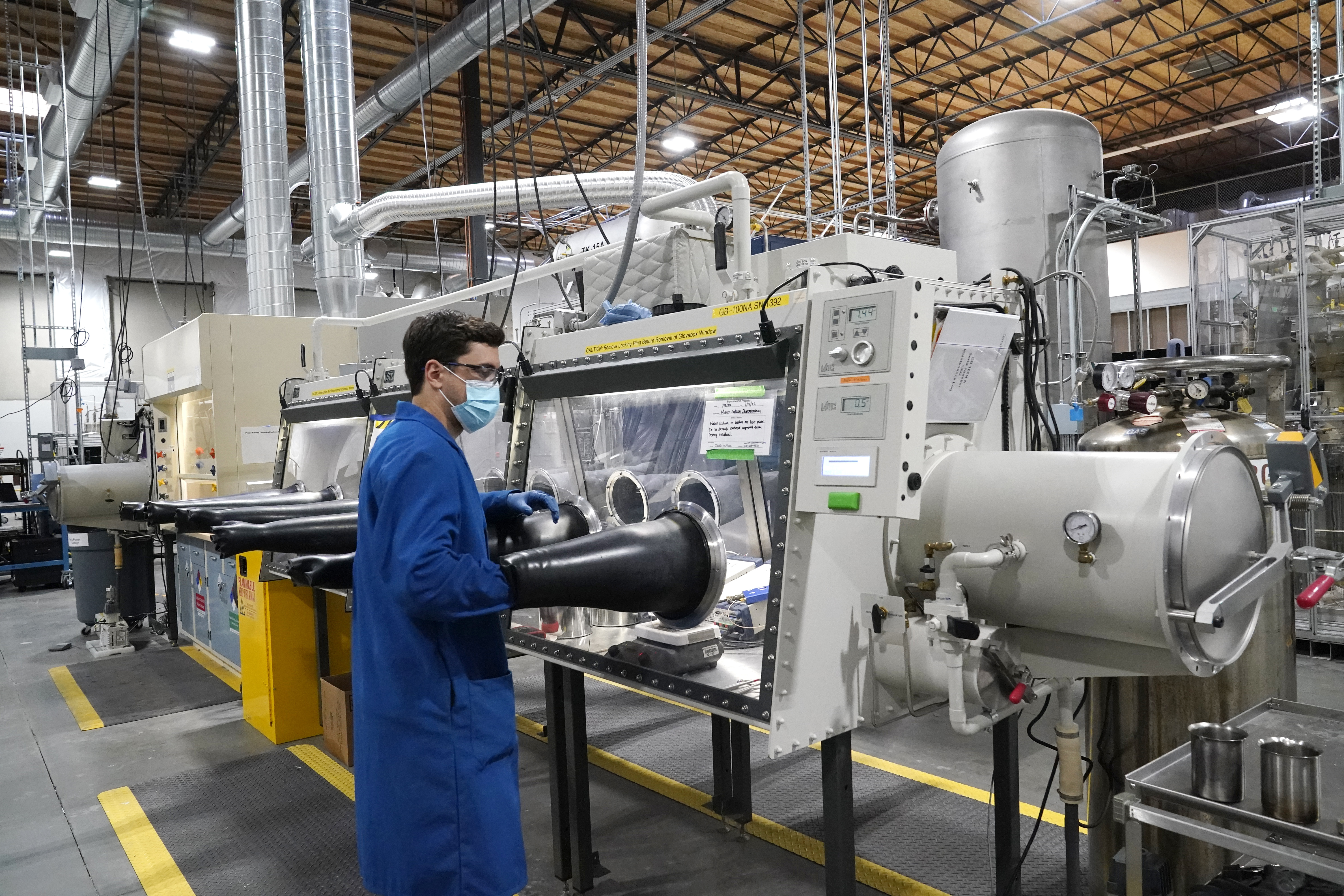 Test engineer Jacob Wilcox pulls his arm out of a glove box used for processing sodium at TerraPower, a company developing and building small nuclear reactors, Thursday, Jan. 13, 2022, in Everett, Wash. In November, Bill Gates' company TerraPower announced it had chosen Kemmerer, Wy., for a nontraditional, sodium-cooled nuclear reactor that will bring on workers from a local coal-fired power plant scheduled to close soon. The project comes as many U.S. states see nuclear emerging as an answer to fill the gap as a transition away from coal, oil and natural gas to reduce greenhouse gas emissions. (AP Photo/Elaine Thompson)
Test engineer Jacob Wilcox pulls his arm out of a glove box used for processing sodium at TerraPower, a company developing and building small nuclear reactors, Thursday, Jan. 13, 2022, in Everett, Wash. In November, Bill Gates' company TerraPower announced it had chosen Kemmerer, Wy., for a nontraditional, sodium-cooled nuclear reactor that will bring on workers from a local coal-fired power plant scheduled to close soon. The project comes as many U.S. states see nuclear emerging as an answer to fill the gap as a transition away from coal, oil and natural gas to reduce greenhouse gas emissions. (AP Photo/Elaine Thompson)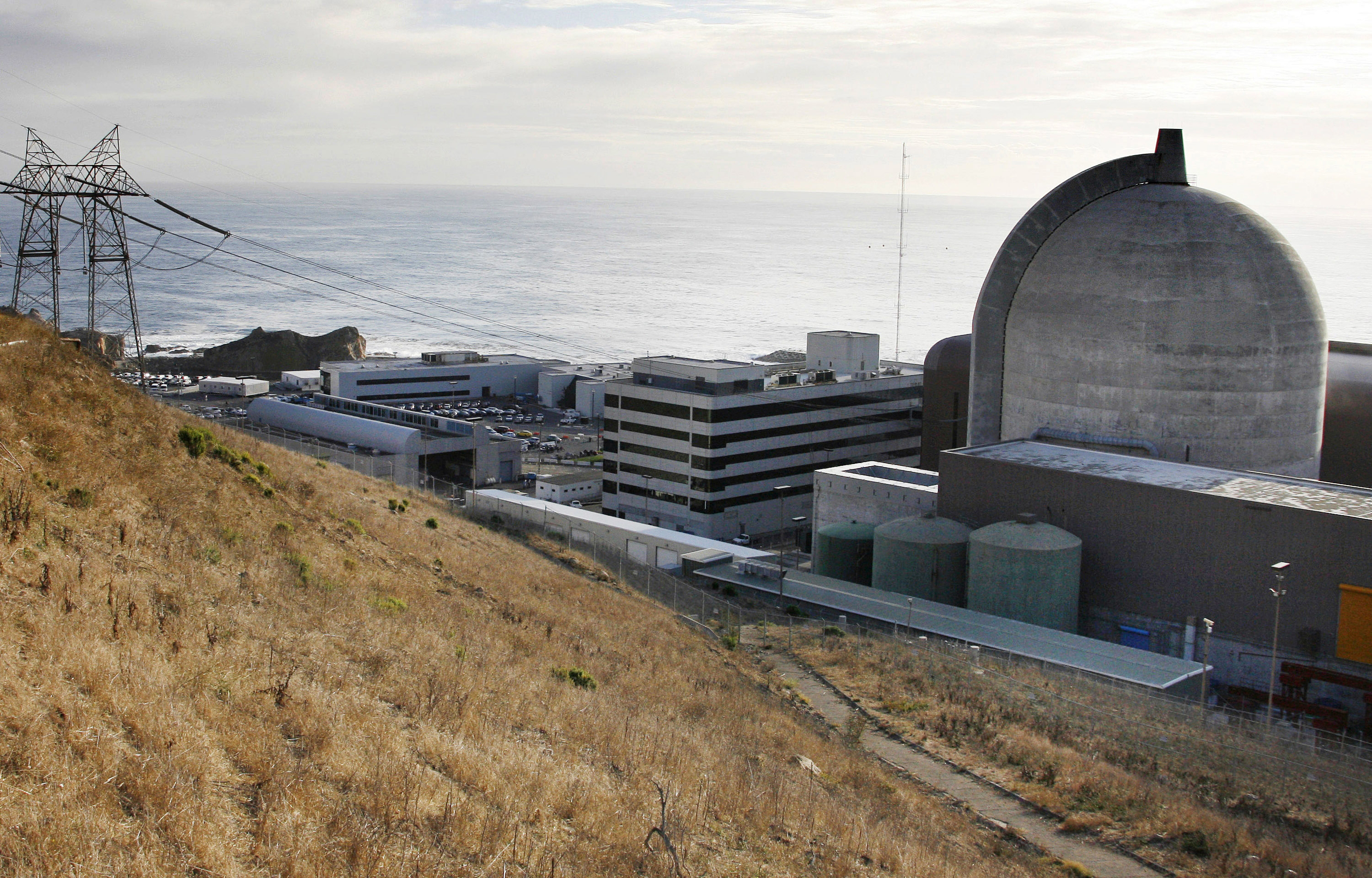 FILE - One of Pacific Gas and Electric's Diablo Canyon Power Plant's nuclear reactors is photographed on Nov. 3, 2008, in Avila Beach, Calif. As climate change pushes states in the U.S. to dramatically cut their use of fossil fuels, many are coming to the conclusion that solar, wind and other renewable power sources won't be enough to keep the lights on. Nuclear power is emerging as an answer to fill the gap as states transition away from coal, oil and natural gas to reduce greenhouse gas emissions and stave off the worst effects of a warming planet. (AP Photo/Michael A. Mariant, File)
FILE - One of Pacific Gas and Electric's Diablo Canyon Power Plant's nuclear reactors is photographed on Nov. 3, 2008, in Avila Beach, Calif. As climate change pushes states in the U.S. to dramatically cut their use of fossil fuels, many are coming to the conclusion that solar, wind and other renewable power sources won't be enough to keep the lights on. Nuclear power is emerging as an answer to fill the gap as states transition away from coal, oil and natural gas to reduce greenhouse gas emissions and stave off the worst effects of a warming planet. (AP Photo/Michael A. Mariant, File)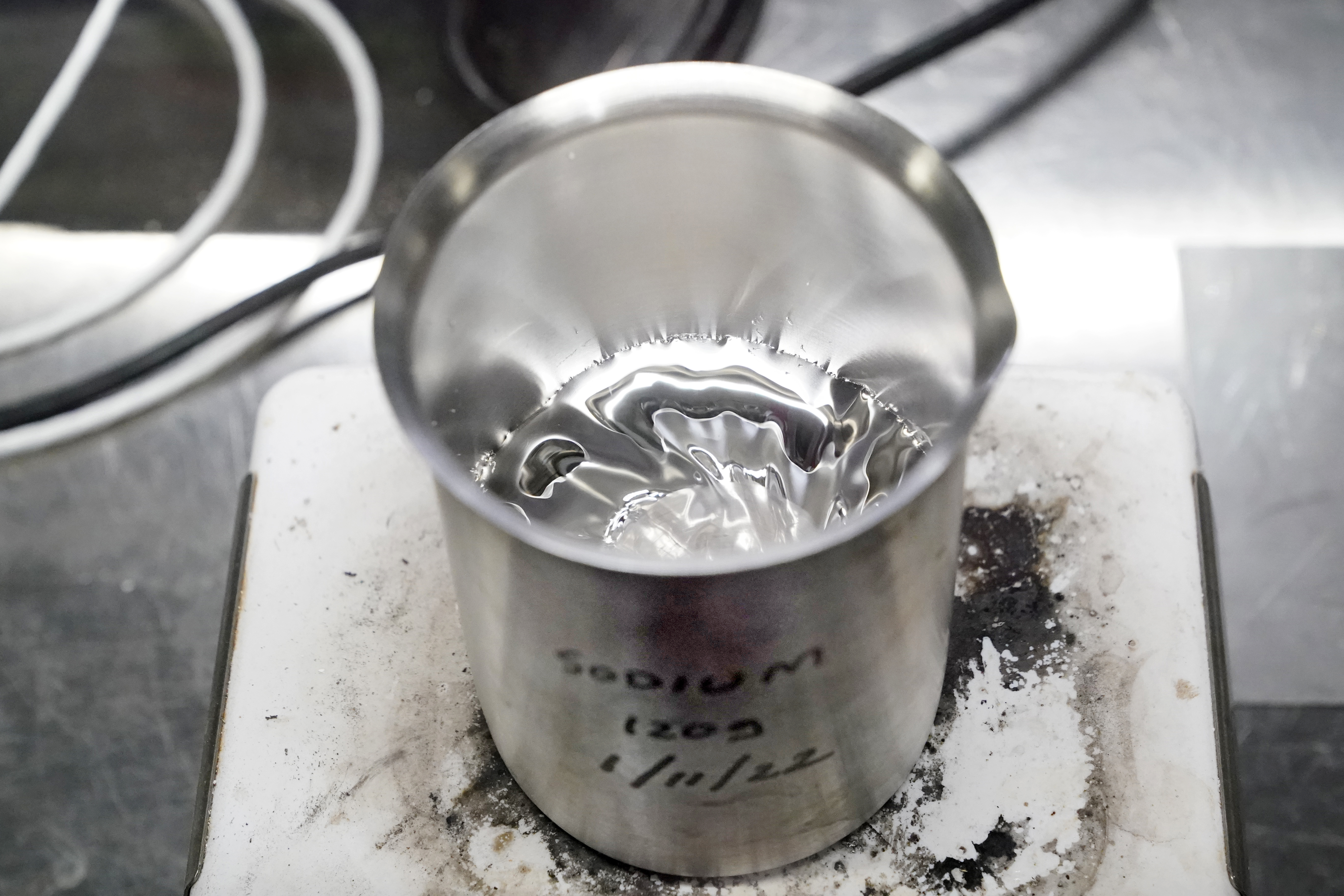 Molten sodium sits in a beaker atop a hot plate as part of a demonstration at TerraPower, a company developing and building small nuclear reactors, Thursday, Jan. 13, 2022, in Everett, Wash. Bill Gates, the man who revolutionized personal computing, is launching an ambitious project to counter climate change: A nationwide reboot of nuclear energy technology. In November, Gates' company TerraPower announced it had chosen Kemmerer, Wy., for a nontraditional, sodium-cooled nuclear reactor that will bring on workers from a local coal-fired power plant scheduled to close soon. The project comes as many U.S. states see nuclear emerging as an answer to fill the gap as a transition away from coal, oil and natural gas to reduce greenhouse gas emissions. (AP Photo/Elaine Thompson)
Molten sodium sits in a beaker atop a hot plate as part of a demonstration at TerraPower, a company developing and building small nuclear reactors, Thursday, Jan. 13, 2022, in Everett, Wash. Bill Gates, the man who revolutionized personal computing, is launching an ambitious project to counter climate change: A nationwide reboot of nuclear energy technology. In November, Gates' company TerraPower announced it had chosen Kemmerer, Wy., for a nontraditional, sodium-cooled nuclear reactor that will bring on workers from a local coal-fired power plant scheduled to close soon. The project comes as many U.S. states see nuclear emerging as an answer to fill the gap as a transition away from coal, oil and natural gas to reduce greenhouse gas emissions. (AP Photo/Elaine Thompson)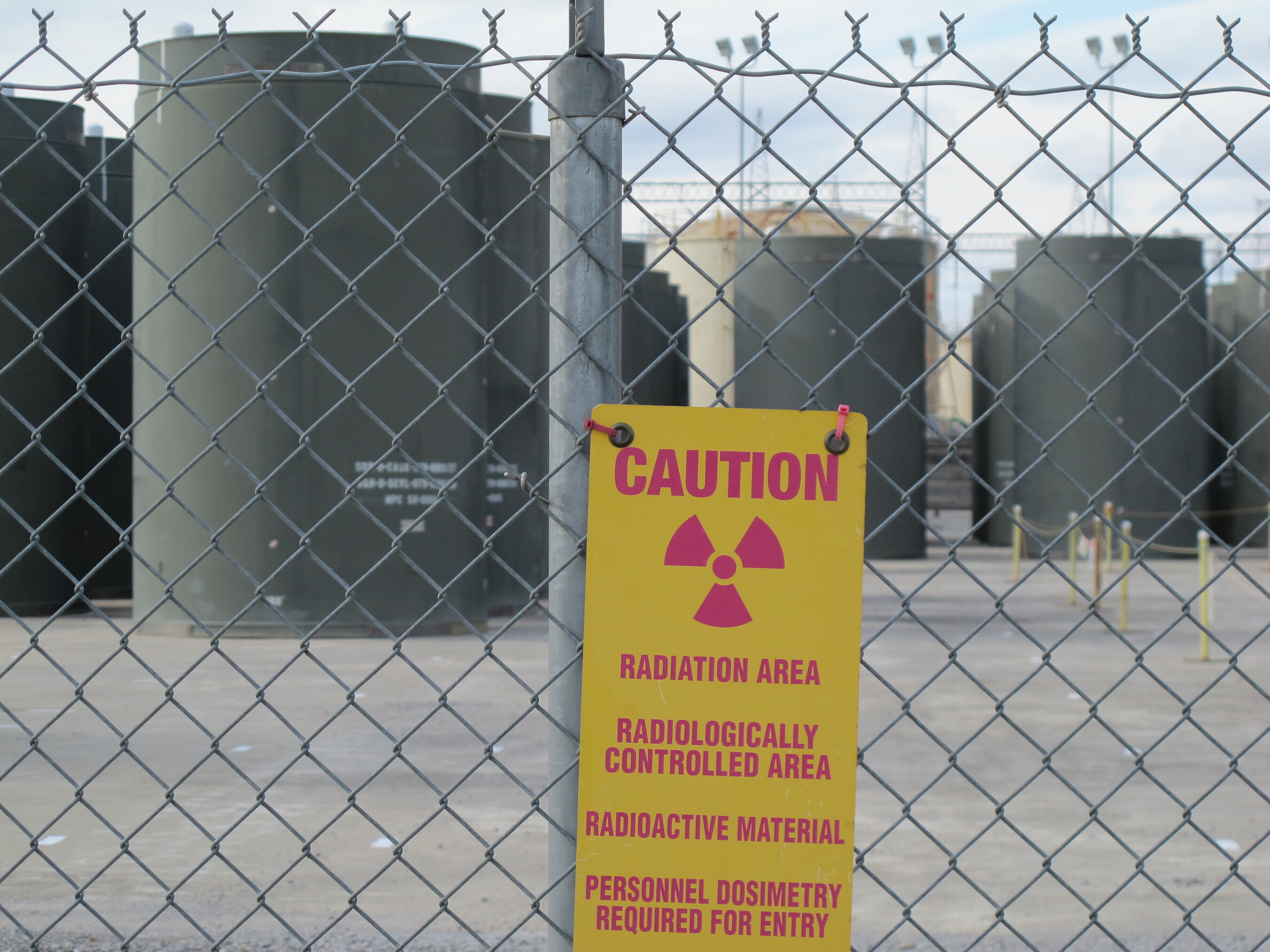 FILE - Steel and concrete containers used for dry storage of spent fuel at the Tennessee Valley Authority's Sequoyah nuclear plant near Chattanooga, Tenn., are shown to the media during a Friday Jan. 13, 2012 tour. As climate change pushes states in the U.S. to dramatically cut their use of fossil fuels, many are coming to the conclusion that solar, wind and other renewable power sources won't be enough to keep the lights on. Nuclear power is emerging as an answer to fill the gap as states transition away from coal, oil and natural gas to reduce greenhouse gas emissions and stave off the worst effects of a warming planet. (AP Photo/ Bill Poovey, File)
FILE - Steel and concrete containers used for dry storage of spent fuel at the Tennessee Valley Authority's Sequoyah nuclear plant near Chattanooga, Tenn., are shown to the media during a Friday Jan. 13, 2012 tour. As climate change pushes states in the U.S. to dramatically cut their use of fossil fuels, many are coming to the conclusion that solar, wind and other renewable power sources won't be enough to keep the lights on. Nuclear power is emerging as an answer to fill the gap as states transition away from coal, oil and natural gas to reduce greenhouse gas emissions and stave off the worst effects of a warming planet. (AP Photo/ Bill Poovey, File) Chris Levesque, president and CEO of TerraPower, a company developing and building small nuclear reactors, displays a fuel assembly model, Thursday, Jan. 13, 2022, in Everett, Wash. The 5-foot model is about one-third actual length and would be vertical when in use, rather than horizontal. By cooling the reactor with liquid sodium, a metal that solidifies at well above room temperature, TerraPower says its relatively small, 345-megawatt plant will be safe and less expensive than conventional, water-cooled nuclear plants. (AP Photo/Elaine Thompson)
Chris Levesque, president and CEO of TerraPower, a company developing and building small nuclear reactors, displays a fuel assembly model, Thursday, Jan. 13, 2022, in Everett, Wash. The 5-foot model is about one-third actual length and would be vertical when in use, rather than horizontal. By cooling the reactor with liquid sodium, a metal that solidifies at well above room temperature, TerraPower says its relatively small, 345-megawatt plant will be safe and less expensive than conventional, water-cooled nuclear plants. (AP Photo/Elaine Thompson)